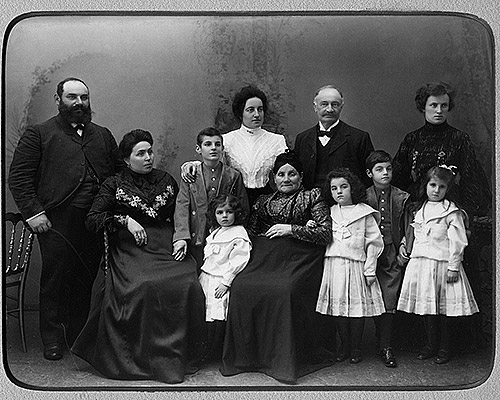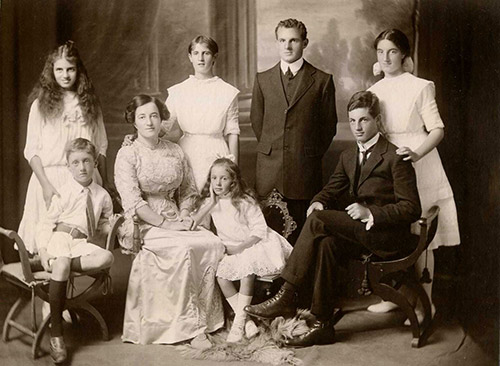Family History
Michael was born in Cape Town, South Africa in 1928 to Hirsch (1896-1981) and Rose (1899-1983) Friedlander. They were part of a large extended family, because both of his parents had many siblings. He never knew his grandfathers, both of whom died a few years before he was born, and he was named for both of them (Michael for Moritz Lewin and Wulf for Wulf Friedlander. His sister, Ruth, born four years later, completed the family.
We are fortunate to have numerous family photos from the early 20th century of both families. (And equally fortunate for Michael in 2010 to have provided detailed captions of who's who.)
Click on the lines with the triangles marked "complete caption" for more details.
Hirsch, Michael's father

Wulf Friedlander and family in Latvia, 1904.
Hirsch is the boy second from right.
Complete caption of 1904 family photo
Names without surnames are Friedlanders.
Man on left (unknown), woman seated on left (unknown), Hessel, Selda (in front), Johanna (in rear), Mother of Jenny Friedlander (who died in 1902), Wulf, Feodora, Hirsch, Annetta, Woman (rear right, unknown, probably Jenny's sister but not certain).
Jenny's father was Ber Friedlander; Jenny & Wulf were first cousins.
The story behind the photo is that Wulf brought his new bride (Johanna) and the 5 children back to see his mother-in-law, the mother of his dead first wife, Jenny, so that she could see who would bring up all the children.
Caption by Michael Friedlander, December 2010.
Like many South African Jewish families, the Friedlanders emigrated from Lativa in the late 19th century. Wulf, a businessman, and his wife Jenny had six children (Evalina died in 1899 at age 7). Jenny died tragically of typhus in 1902, leaving Wulf with five children to raise on his own. He remarried about two years later to Johanna and had three more children. In 1904, Wulf took the entire family back to Latvia so that his first mother-in-law, Jenny's mother, could meet the woman (Johanna) who would be raising all those children. (Thus Johanna was the one Michael would know as his paternal grandmother.)
In 1902, Wulf and his brother Isaac founded the railroad town of De Aar, about 500 miles from each of Cape Town and from Johannesburg. To this day, the main street running next to the railroad station is Friedlander Street [map]. (See 1997 photo.) There are also streets named for each of their wives (Jenny Street, Alida Street). The brothers ran the hotel there and also laid out the town grid.

Johanna Friedlander and family, 1912.
Hirsch is seated at right.
Complete caption of 1912 family photo
Rear (L-R): Selda, Annetta, Hessel, Feodora
Front row: Max, Johanna, Sybil, Hirsch
(Kenneth was born in Aug 1912 and is not in this photo)
Caption by Michael Friedlander, Hirsch's son, December 2010.
Hirsch went to college at an agricultural college in Grootfontein, graduating (in 1916). Later he saw action in World War I, on horseback in East Africa.
Rose, Michael's mother

Michael's maternal grandparents, Jenny & Moritz Lewin (center with hat and at right).
Oudtshoorn, South Africa, 1904.
Complete caption of 1904 Lewin family photo
& sister of Moritz Lewin; later married Dr. Israel Stusser];
Unknown; Jenny Lewin (wife of Moritz); Gertrude (Trude) Sachs (married Sam Sanders;
mother of Rhoda & Aubrey Sanders); Moritz Lewin;
Caption by Michael Friedlander (grandson of Jenny & Moritz);
December 2010.; Scanned in March 2001.

Lewin children circa 1911 (Michael's mother Rose at right)
Oudtshoorn, South Africa, 1911.
Complete caption of 1911 Lewin children photo
as identified by Michael Friedlander, Rose's son, in Dec 2010.
Michael's mother Rose grew up in Oudtshoorn, then and now known as the "ostrich capital of the world," about 260 miles from Cape Town. Up through World War I or so ostrich feathers were considered the height of fashion (for women's hats and more), thus people managing farms there could be very successful. (Ostrich feathers were apparently South Africa's fourth largest export, after gold, diamonds, and wool!)
Rose was a bright young woman and, unusual for her day, had the opportunity to go to college. (She graduated from the University of Cape Town in 1920.)

Wedding of Michael's parents, Hirsch and Rose Friedlander, May 1926.
Complete caption of 1926 wedding photo
Standing from left: Gertie Lewin (Rose's sister), Sally Kussel (friend of Rose),
Ralph Asherson (friend of Hirsch), Selda Friedlander (Hirsch's sister)
Caption by Michael Friedlander (Hirsch & Rose's son), December 2010.
In college, Rose became friends with Feodora Friedlander (Hirsch's sister). Rose was invited to a family get-together for a Jewish holiday at the Friedlanders, and thus met Hirsch in that way.
Rose's father Moritz died in June 1925 at just age 55, and Rose & Hirsch delayed their wedding as a result to May of the following year (1926).

Portrait of Rabbi Dob Joel Sachs (1771-1834),
an ancestor (4x great-grandfather) of Michael's.
Complete caption of Rabbi Sachs portrait
Rabbi Michael Chassid Sachs (1668-1728)
Rabbi Joel Sachs (1712-1770)
Rabbi Dob Joel Sachs (1771-1834) [← This portrait]
Rabbi Levi Sachs (1795-1853)
Samuel Sachs (1812-1871)
Abraham Sachs (1842-1894)
Jenny Sachs (later Lewin) (1874-1949)
Rose Lewin (later Friedlander) 1899- [1983]
Michael W Friedlander (1928- )
Ruth Jenny Friedlander (1932- )
Caption by Rose Friedlander (Michael's mother),
date of caption unknown.
Rabbi Dob Joel Sachs
One more unusual item to mention: a portrait of a family member, copies of which have been reproduced and handed down for generations.
I (David) grew up with a black-and-white copy of this portrait hanging in Michael's study. Many years later, we found a second copy of it (which had come from my grandparents' home?) which hangs in our home in Maryland. Both copies have a family tree written on the back, which makes clear that Michael's mother was descended from a line of rabbis, of whom the subject here, Rabbi Dob Joel Sachs (1771-1834), was Michael's 4x great-grandfather (six generations back).
It was not until 2007 that we learned that the original was in color! (At that time, Michael had learned that a family member in Israel had the original, and he requested that someone shoot a digital photo of it, which is the image shown here.)
Even more interesting was how the portrait came to be: An orthodox rabbi (there was no other kind in that day!) would never have permitted to have his portrait painted under normal circumstances. According to family lore, King Wilhelm III of Prussia was so taken with Rabbi Sachs' appearance (during an audience) that he wished to have the rabbi's portrait painted. Rabbi Sachs consented on the stipulation that specific concessions be made for the (improvement of the) treatment of the Jewish community in his town.

Michael and grandson Rafael at the
Smithsonian Hirshhorn Museum,
Washington, DC, June 2011.
How Joseph Hirshhorn is related
The museum for modern art at the Smithsonian Institution in Washington, D.C is the Hirshhorn Museum. It turns out that Joseph Hirshhorn's mother was a Friedlander, and the connection is not all that distant!
His bio at his eponymous Smithsonian Museum is here.
| Friedlander family tree (partial) | |
| Zvi Hirsch (b. 1760) | |
| Hessel (b. 1790) | |
| Shimon (b. 1823) | Hirsch (also b. 1823?) |
| Amelia (b. 1860) | Wulf (b. 1846) |
| Joseph Hirshhorn (b. 1899) | Hirsch (b. 1896) |
| Michael (b. 1928) | |
So:
Amelia Friedlander's grandfather (Hessel) was also Michael's 2x-great-grandfather (Hessel)
or
Amelia Friedlander's father and Michael's great-grandfather were brothers (Shimon & Hirsch)
and
Joseph Hirshhorn and Michael's father Hirsch were second cousins.
and thus
Joseph Hirshhorn and Michael were second cousins, once-removed.
To see a picture of Amelia Friedlander Hirshhorn, see a page from Joseph Hirshhorn's daughter Gene LaPere's book: Bringing the Past to Life, Part II here.



